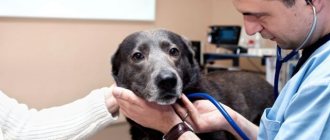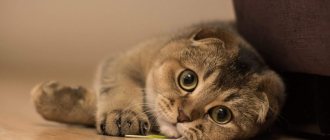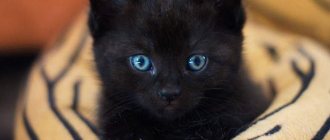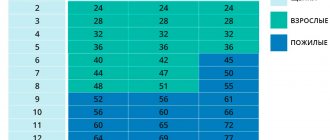It is often said that the age of a cat or dog can be “converted to human age” by simply multiplying the animal’s number of years by 7. With such a counting system, a one-year-old animal would correspond to a seven-year-old child, a two-year-old cat would correspond to a fourteen-year-old teenager, and a twelve-year-old cat would correspond to a 96-year-old man. A cat's twenty years would correspond to a human's 140 years, and so on. However, in reality, this does not allow for a truly clear comparison of all stages of development of human and cat organisms.
We follow a different, much more meaningful comparative methodology.
Here's how to calculate a cat's age in human terms: let's consider the first year
The life of a cat is equivalent to
fifteen years
of a human;
the second year
corresponds to
24 years
of human life.
Each subsequent year
can be considered to correspond to
four years
. With this counting system, a cat's age of 12 years corresponds to the age of a 64-year-old person (24+).
If a cat is lucky enough to live more than sixteen years, then the subsequent years can perhaps be multiplied by three, equating each year to three human years.
When you start to look closely at a cat's life, you see that this comparison makes perfect sense. For example, in the first year of life, a cat learns to live independently and independently of its mother, learns to hunt, get food, and get along with its new family. In the first year, the cat usually reaches sexual maturity (with some cats this happens as early as six months). Most members of the human race reach sexual maturity at about fifteen years of age.
A two-year-old cat is already a fully grown animal with an established character and attitude to life, she already knows what she wants from others, and understands perfectly well how she can achieve this - some people only just manage to reach this level by the age of 24 !
A cat can be considered to have reached middle age when it reaches eight years of age
. Different cats, just as with people, are affected differently by the ravages of time, so that the period of middle age can stretch out for an indefinite period of time - from eight years to about sixteen. Just as some people are able to run a marathon at 70 years old, or even go on hikes at more than 80 years old, some cats at twenty years old happily continue to carry caught mice to their owners, while others can barely get in at ten years old. on a bench to warm my old bones.
If we consider that twelve years is the age at which a cat has reached retirement, then a fifteen-year-old cat may well correspond to a strong and well-preserved person of 76 years old, while twenty-year-olds are as rare as old people of 92 years old.
Those rare people who manage to live more than 30 years - 124 years by human standards - are simply unique, it’s inexplicable! Maybe it makes sense to develop a special ceremony and name these amazing cats Methuselahs.
Of course, the lifespan of animals largely depends on the conditions and animals. Typically, domestic animals have a longer lifespan than stray animals of the same species. Many animals in zoos live longer than their “free” relatives, thanks to the fact that specialists closely monitor their nutrition and the conditions of their detention. However, it also happens that animals in captivity live less than in nature. This happens with exotic animals, whose owners are often not aware of the rules for caring for them.
The average lifespan of cats is 10-15 years. For various reasons, stray cats live much shorter: 3 - 5 years. There are also long-lived cats
. Thus, according to the Guinness Book of Records, the spotted cat Ma from the UK and the Granpa Rex Alen cat from the USA lived the longest of all known domestic cats, 34 years each.
When a furry creature lives in the house, household members become interested in how to calculate a cat’s human age. At first glance it may seem like an idle question. However, drawing an analogy between the age of a pet and the years of a person’s life has practical significance. Knowing how old a pet is in human terms, owners will be able to adjust the upbringing of the animal and approach health and maintenance issues accordingly.
Let's make an analogy
It is not so difficult to find out the age of a domestic cat. To do this, you can simply look at the veterinary passport of your purebred pet. If the cat was picked up on the street or there is no information about its date of birth, then a veterinarian can help determine its age. This is done by assessing their condition. However, the announced figure is unlikely to be informative and will give a complete picture of the youth or old age of the animal. There are several more options for calculating the age of a cat.
Most cat breeders know that if the pet’s years are multiplied by a factor of 7, then this will correspond to the person’s age. Taking this method as a basis, it turns out that a kitten up to one year old in its mental development resembles a 7-year-old child. However, this simplified method is incorrect. In fact, a cat that is over one year old is developmentally equivalent to an adult 18-year-old person.
Experienced breeders and experts in the field of zoopsychology offer a more complex, but correct method for calculating the age of a cat. According to this method of recalculation, in the first year of life, when the animal develops physically, the formation of the pet’s psyche occurs, equivalent to the age of a child of 15 years. A cat's youth is characterized by the blossoming of physical fitness and puberty.
Young animals during this period are already similar to adults, but continue to play and frolic with pleasure. Veterinarians recommend that owners at this age not engage in breeding, but wait 1.5 - 2 years.
When a cat is 2 years old, it is approaching 24 years of human life. This is the most optimal time for the first birth in females and mating in males. The most active and cheerful time lasts for pets until they are 3 years old, when their age corresponds to 28 years by human standards.
After 2 years, 4 should be added to each previous year. Thus, an adult cat that is 6 years old will correspond to the age of 40 years for a person. The period of life of pets from 2 to 6 - 7 years is characterized by the most active sexual functions. After the seven-year mark, veterinary specialists and breeders recommend stopping reproductive function to prevent health problems and the risk of having defective offspring.
This technique most accurately helps to understand how age is calculated in cats. After the pet turns 16 years old, which corresponds to extreme human old age (a person would be 83 years old), 3 should be added to each year.
By behavior
It is possible to determine the age of a pet by its behavior. This method is quite subjective and depends on the character of the animal, but there are still common features in habits.
Baby kittens spend almost all their free time playing and communicating with each other and people. They are even ready to courageously sacrifice minutes of sleep for the sake of fun! Some kids even insistently demand attention to themselves.
Mature pets will enjoy spending time hunting and playing. However, they tend to be very sleepy.
Top articles: Marble cat
Older cats no longer like unnecessary fuss, preferring quiet rest to noisy games. Pets can often be found dozing peacefully on a chair or on your bed. As cats age, their hearing often becomes dull and their vision begins to decline, which can cause the animal to become a little more fearful or nervous.
About the importance of calculations
Drawing an analogy between the age of an animal and human years is of practical importance for proper upbringing and maintenance. Thus, many owners mistakenly believe that a six-month-old kitten is just a small child 3 to 5 years old. In fact, the baby corresponded to this childhood age at 3 - 4 months. It is important to know this feature so as not to miss the moment of raising and socializing a young animal.
If you treat a 6-month-old kitten like a child aged 10-12 years, then you can understand what is acceptable in a pet’s behavior and what is an oversight in upbringing. Through games and entertainment, a young animal should develop social behavior skills and the concept of prohibitions. At the age of one year, the attitude of household members towards a cat that is already adult in their opinion should be like that of a 15-16 year old teenager. In no case should a pet be mated until it is a year old; this is too early for the animal’s fragile psyche.
Until the age of 6, the animal is full of strength and energy and is capable of actively reproducing offspring. There are practically no health problems observed during this period. It is characterized by the animal’s greatest activity; the pet is healthy and full of energy.
After 7 - 8 years, a cat's old age begins with corresponding restrictions and problems. By this period, responsible owners either carry out the animal or stop the reproduction of offspring by other means. As a rule, it is at this age, which corresponds to 44 - 48 years of age for a person, that the animal begins to have health problems.
Knowing how long a cat’s year is considered by human standards, it is not difficult for the owner to understand that a pet at the age of 10-11 years has already reached “retirement” age. The cat sleeps more, does not take part in games, and may have senile sores. The owner and household members should take into account the peculiarities of the physiological state of their elderly pet.
Stages of cat development by human standards
A person has the following stages of life:
- childhood period;
- adult stage;
- mature age;
- elderly stage and old age.
Childhood period
At this stage, the external boundaries are blurred in cats and humans. There are cases where girls as young as 12 become mothers. At the same time, the period of human growth ends at 25 years. With reservations for the period of childhood, cats are considered to be up to 6 months old. From this time on, it is customary for pets to be switched to two meals a day; their increase in food consumption stops.
Pharmacists differentiate the dosage of tablets according to the following principle: for adults and children over 12 years of age, or for children under 12. Restrictions on the use of a number of veterinary drugs for kittens are lifted upon reaching the age of six months.
Adult stage
The period of adulthood in a person is conventionally divided into adolescence, young adulthood and adulthood itself. Otherwise, these ages can be called adolescence and childbearing. A cat is considered a juvenile if it is older than 6 but younger than 12 months. The animal is ready for fertilization, but it is not recommended to breed a pet before 15-18 months. A cat up to two years old and a person up to 25 years old are considered young.
Theoretically, women under 40 years of age are considered to be of reproductive age; in practice, it is not recommended to become pregnant after 35. The breeding use of cats is limited to 5-6 years. In order not to spoil the breed, producers of both sexes are recommended to be neutered at this time. Manufacturers of ready-made food produce Adult food for cats from 1 to 7 years old. Pets over 7 are considered seniors and special food is prepared for them.
Be sure to read:
Valerian for cats: what is it for, how does it affect the animal, what will happen if given, benefits and harms
Mature age
A person is considered mature between the ages of 40 and 60. At this time, symptoms of chronic diseases appear, a person gives up bad habits and extreme rhythms of life. Change is greatly influenced by reason and life experience.
Not so with cats. Animals from 7 to 10 years old are considered mature. Reason and life experience do not have a significant impact on the lifestyle of pets. Cats continue to regularly scream during menstruation and bear offspring twice a year. Cats become even lazier than before, but continue to participate in the struggle for procreation. Everything is true
Elderly stage and old age
The concept of an elderly person is individual. For some, decrepitude occurs before 50, while others are vigorous and cheerful even after 80. For outside observers, it seems that time has stood still for cats. The pet also meows invitingly and brings kittens like 10 years ago. But now, some kind of lump has appeared on her stomach, it is gradually growing.
My health is gradually deteriorating. The cat endures pain and falls into a helpless state several weeks or days before death.
Cat age
When purchasing a furry friend, the owner and household members must understand that cats do not live as long as humans. When figuring out how many years a cat goes through a year, the owner is most often interested in the animal’s life expectancy. An indicator such as the average life expectancy of furry couch potatoes depends on many factors.
Of course, the lifespan of a cat is a very average indicator. Pets are known to live 30 years or more. However, such long-livers are rather an exception in the world of furry couch potatoes.
How to extend the life of a pet
Wanting to know the answer to the question of how long a cat's year is considered, the owner is not just showing curiosity. First of all, such data will help prolong the life of your beloved couch potato. In order for a cat to delight family members with its presence for a long time, the owner should know how to prolong the life of a furry pet:
- For each breed, you should follow the advice and recommendations of breeders on.
- Conduct routine vaccination against infectious diseases.
- If an animal is not of breed value, then to increase its life expectancy it should be castrated or sterilized at an early age.
- Regular preventive examinations by a veterinarian allow you to identify diseases at an early stage, as well as adjust housing and nutritional conditions. After 6 - 7 years, the cat should be taken to the clinic every six months, including ultrasound diagnostics of internal organs.
- Feeding your pet premium and super-premium food will prevent the development of many diseases and prolong the life of your furry homebody.
The owner, knowing how to calculate the age of a cat, will be able to avoid many mistakes in keeping a pet. Raising, caring for, feeding, and caring for the health of an animal must correspond to its age, physical and mental condition.
How to calculate how old a cat is? This question may concern many who pick up stray animals or for some reason do not know the date of birth of their pet.
Today, the life expectancy of cats tends to increase and is approximately 12-17 years. Typically, cats living at home live up to 18 years, sometimes more. But cats with access to the street have a shorter life expectancy due to the dangers that may lie in wait for them on the street: cars, consumption of dangerous foods, human factor, etc.
The life expectancy of your pet is influenced by many reasons: heredity, quality of life, including quality of nutrition (read) and in general.
Cats tend to mature quickly. A year after their birth, they are already fully developed and reach sexual maturity. Therefore, compared to humans, cats have an extremely short childhood.
You can understand how to determine the age of a kitten using the following criteria:
Teeth. How to determine a cat's age by its teeth
Teeth are a good indicator for determining the age of a kitten. Baby teeth appear between two and four weeks of age. Later, milk teeth are replaced by permanent teeth, and tooth replacement occurs at the age of about 3-4 months.
By opening your mouth and finding permanent white teeth there, you can say that you have a cat about a year old, maximum one and a half years old. Slight yellowing of the teeth or the presence of tartar indicates an age of approximately 1.5 - 2 years.
The presence of tartar on all teeth is approximately 3-5 years. The absence of teeth in a cat's mouth can indicate a very old age.
However, it should be noted that teeth are not an absolutely accurate indicator of the age of an animal. They may be in poor condition due to improper care of the animal, or, on the contrary, snow-white teeth may mislead you when calculating the age and only indicate impeccable care for the animal.
Here is an approximate list by which, by looking into your pet’s oral cavity, you can approximately determine how old he is:
- 2-4 weeks - baby teeth erupt;
- 3-4 months - replacement of baby teeth begins;
- 5-6 months - complete replacement of baby teeth with permanent ones;
- 1 year - healthy cats have white teeth without much tartar;
- 2 years - the middle incisors on the lower jaw wear away, the enamel turns yellow, and tartar accumulates;
- 3-5 years - the central incisors of the upper jaw, the outermost incisors and canines are worn out;
- 6-7 years - the pigmentation of tooth enamel is disturbed, the outer incisors of the upper jaw are erased;
- from the age of 10, the central incisors begin to fall out, then the middle and extreme ones;
- By the age of 15-18, fangs fall out.
Puberty
If your cat is trying to mark its territory, the urine has a specific strong odor - this indicates that the pet has reached sexual maturity (usually this happens at the age of about 5-6 months). Mature cats become very affectionate and emit loud meows. They go into heat, calling for potential suitors, starting at the age of 5 – 12 months.
Appearance of wool
Younger cats have soft, fine fur. With age, the coat becomes coarser, the color may lighten or, on the contrary, darken. Older animals, like people, have gray hair, individual white or gray hairs, as well as entire spots, may appear.
Eyes
Juveniles usually have clean, clear and bright eyes. With age, you may notice a change in eye color or the presence of clouding, pigmentation disorders of the iris. They are developing.
Is it possible to increase the lifespan of a cat?
Any owner dreams of having a furry family member to please him for as long as possible. And he has the power to do everything so that the cat lives for 15, or even 20 years. What will prolong the life of your beloved four-legged animal:
- Annual vaccination
. The kitten is vaccinated in the first 2-3 months of life and then the procedure is repeated every year. This will protect both your indoor and outdoor cats from the most terrible viruses with a high fatality rate.
- Routine examination by a veterinarian
. Non-pedigreed cats get sick less, so they can be shown to the veterinarian during vaccination once a year - just ask the doctor about this. Pedigree animals and animals with chronic diseases require more frequent visits to the veterinary clinic - the frequency will be determined by the veterinarian himself.
- Sterilization and castration
. If you do not plan to breed kittens, be sure to sterilize your pet - this will help avoid many problems, including diseases of the genitourinary system and mental disorders.
- Attention to any changes in your pet's behavior
. Has your cat started drinking a lot? Stopped sleeping in your favorite chair? Is he limping? Are there strange discharges? Even such little things require close attention from the owner. The first action in case of suspicion is to call the veterinarian, he will tell you whether you need to take the animal to the clinic or if you can watch it at home.
- Purity
- the key to health. Cats groom themselves, but this is not enough to maintain hygiene. For example, long-haired breeds cannot cope with caring for a luxurious fur coat, and it must be combed regularly to prevent parasites or skin diseases. It is necessary to thoroughly rinse the cat's food and water bowls, disinfect the trays, and wash the bedding.
- Nutrition
must be maintained at a high level. It is not so important what you feed your cat - the main thing is that the selected diet suits it. A young cat will benefit from both natural food and high-quality dry food. But kittens and elderly individuals require a special menu, which cannot be cheap. Therefore, before getting a cat, think about the fact that in old age, in 95% of cases, it will require greater expenses than in youth.
- Treat your cat like a family member
. Consider the nature of the pet and its needs. If she doesn't tolerate loneliness well, you shouldn't leave her in the apartment all day. And on the contrary - if the kitty loves isolation, respect her personal space. There are many such points, and if you do not pay attention to the psychological state of the animal, it will constantly be sick and will not live very long.
This is not a complete list of what a loving owner can do. The most important thing is to be attentive and patient, treating your pet as a younger member of the family. Then he will live very long and happily.
Cat's age in relation to humans
1 cat year is 15 human years
Speaking about homeliness and comfort, it is simply impossible not to talk about the cutest, but laziest animals - cats and kittens. These furry creatures make our lives much better by giving us their warmth and love. And for sure, every owner has thought about how old his pet is, if we translate this into human standards. Perhaps the answer to this question would help you understand your cat’s behavior. After all, it is age that affects the physical and spiritual state of both humans and animals. Perhaps the reason for all the dirty tricks and playful mood is just a youthful period, but the sadness in the eyes of your pet is due to the fact that he is having a midlife crisis. You will learn how to find out the age of your cat in today's article.
Does breed affect life expectancy?
Actually the answer to this question is yes. They can live much longer:
- mongrel cats;
- animals of natural or long-bred breeds.
Exotic cat breeds bred by humans live much shorter lives.
The reason lies in the fact that in order to preserve the characteristics of the breed (in the British , Maine Coons , Munchkins, Cornish Rex, exotics ), a small number of individuals are involved in breeding.
Cats that are not bred through selective breeding have much better developed immune systems and survival abilities.
Older cats need to rest more often
Cat arithmetic
Very often, cat owners ask themselves the following question: “How old is our Barsik?” This question is especially relevant when your beloved pet was taken from the street. It is not very difficult to understand this issue, because by counting how many years your cat has already lived with you and adding the approximate age until he appeared in your life, you can determine the correct age. But what do the 3 or 4 years you count say? Judging by human standards, this is just a child who needs careful care. But in a cat's life everything is different. How to convert a cat's age to a person's age?
Surely, if you ask this question to someone, you will hear that cat arithmetic is the simplest science. According to many “experts”, 1 year of a cat’s life is equal to 7 human years. But, if you count it this way, then at 2 years old, your Barsik will already be a real teenager. And if your pet has been living next to you for more than 10 years, then saying that he is an 80-year-old man is completely absurd. But, if we remember that a domestic cat in good conditions can live up to 20 years, and if we translate this into human standards, according to the so-called cat arithmetic, we can get a record 140 years. Therefore, it is not worth doing such a translation, because you can attribute several dozen extra years to your cat.
The ratio of the age of a cat to a person is, first of all, a calculation in which it is very important to take into account the real age of your pet. So, how can you find out and calculate the age of a cat in accordance with human standards?
The first year of your pet's life is equal to 15 years of human life, this figure is quite large, but it is really true for the cat's age. The second year is equivalent to 24-25 years of age. After this, you should simply add 4 years. Thus, at 3 years old, your cat will be approximately 28 human years old. If your cat has lived for more than 16 years, then his 1 year of life should be counted as 3 years of human years. There is also a special table by which you can easily determine what age your pet is.
Elderly (15-19 years old) and old age (over 19 years old)
If you monitor your cat’s health, then even in old age (15-19 years) he will be quite vigorous, resembling a person from 60 to 75 years old. Of course, the cat’s activity will decrease, his habits and daily cycles will begin to change, and he will require more careful and attentive care.
Read about caring for an elderly pet: Features of caring for old cats
We would be lying if we say that a cat after 17-18 years can be completely healthy. In the end, sooner or later a person inevitably begins to have health problems. But even in these years, the owner and the pet can give each other joy, good care, attention and care can make the last years of the pet easier and delay the inevitable death, ideally closer to 23-25 years. And the record-breaking cat, by the way, lived for 38 years!
Features of a cat's age
The second version of the translation can really be considered the most truthful, because based on it, you can get a similarity of ages. For example, 1 year of a cat’s life is, of course, the beginning. In the first months, the kitten gets comfortable and gets to know the people who surround him, learns to jump, and of course, get food and take care of himself. By 9 months, puberty begins, just like in humans.
At 2 years old, it develops into a real young individual, which has already formed its own tastes, characteristics and character. Cats at this age do an excellent job of being manipulated by their owners. Also at this age, your pet can become the mother or father of future offspring. And if we consider this by human standards, then this is really a 24-year-old man.
Speaking about older cats and cats, it is impossible not to mention the midlife crisis, which occurs in both people and animals. During this period, your cat may simply become uncontrollable, his behavior may shock you, but do not rush to get upset because such depression will soon pass. At the age of 15-16 years, your cat becomes a real old man. During this period, corresponding ones may begin, which, unfortunately, are inevitable.
Nutrition depending on age
At each individual period of life, cats need a certain diet. What will invigorate an active kitten, the stomach of an old pet simply cannot digest.
Owners of small kittens should definitely prepare a menu rich in vitamins for them. The diet should include fermented milk products, boiled meat and fish. The yolk is also good for babies. And vegetables and semolina will help kittens grow healthy and active.
An adult cat needs a nutritious diet no less. Depending on the breed, the menu should include meat products. Occasionally you can treat your pet to fish. But only if he is not sterilized!
Fermented milk products in small portions will help improve digestion, and porridge and boiled vegetables will saturate the animal with essential vitamins.
Elderly animals need a special menu. Due to dental problems, cats need soft or crushed food. You should also prevent your pet from becoming obese. If it’s difficult to feel the ribs on your cat’s body, then it’s time to reduce the portion. The diet of an old animal must be balanced, it must contain calcium and taurine.
How to extend the age of your pet?
According to many veterinarians and owners, cats live on average from 10 to 15 years.
These are quite long periods, because translating this to human age, we get approximately the same level of life expectancy. But there are cases when a domestic cat lives up to 20 years, or even more. How to extend the life of your pet? First of all, do not forget that you are unlikely to be able to achieve record results, but adding a couple of years to your life is quite within your power.
You should remember about timely visits to the veterinarian. Also remember that taking vitamins is just as important for cats as it is for humans.
If you do not know which vitamins are required for full development, and in what form they should be, consult a veterinarian. And, of course, the owner’s love for the pet. After all, it is love and care that will give your pet a bright and wonderful life. Love your pets and take care of them, because without them our life will be very boring and ordinary.
Cat habits change with age, and often the owners of these animals try to find out the cat's age by human standards so that the pet's antics and tricks do not take them by surprise. Determining the age of a cat by human standards is not as simple as it might seem at first glance. The fact is that the thinking of people is radically different from the habits of our pets, since they live only by instincts.
Time passes much faster for them than for people. There are 3 main ways to determine how old a pet is by human standards:
- Odds table;
- Ratio;
- Simple arithmetic.
Remember that all the cat ages provided in the table by human standards will be very approximate, since it is impossible to accurately assess the level of intelligence of the animal even with a thorough examination.
Childhood (3-4 – 6 months)
A kitten, like a child, actively explores the world and reaches out to its elders (keep in mind that the owner is like a parent for a kitten). Physically, he is growing very quickly, and his irrepressible energy and thirst to explore everything around him require active action. On the one hand, this is a very interesting period for observing a kitten - every day will bring something new. On the other hand, it’s not for nothing that they say that disadvantages are the other side of advantages (as well as vice versa). All this is very good if you or someone in your family are willing to devote a lot of time to the kitten (at least several hours a day): for play, for feeding 6-7 times a day, for frequent visits to the veterinarian (like children, kittens often get sick). You need to be prepared for sleepless nights (however, active games during the day will allow you to sleep better), for overturned things (and, if you are careless, broken), and for the fact that the kitten will require a lot of attention. If you are not ready for this, if you don’t have time for this, then you yourself will miss such an interesting stage in your pet’s life, and you will make him unhappy, perhaps even jeopardizing his health. Or the kitten will simply find something to do alone, and you will be angry about the disorder in the apartment and, in the worst case, decide to part with it.
To avoid all this, if you have a shortage of free time, we recommend that you take an adult pet - it is calmer and more independent and can tolerate loneliness more easily.
Read more: Adopting an adult cat is not a problem!
Odds table
The most popular method is to use a coefficient table. This is a special number that approximately determines how many human years pass while a pet lives 1 year.
It is incorrect to compare the psychological characteristics, logic and thinking of cats and people, so scientists have created a special plate showing the ratio of cat and human ages. If the exact age is unknown, any veterinarian can determine it (by the animal’s teeth and the general condition of the body).
The first option is calculation with a coefficient
To find out how old a cat is by human standards, a coefficient is often used.
This number determines the number of human years a cat lives in one year.
Each age group has its own characteristics
The calculations are based on social and emotional characteristics.
After all, comparing the logic of a person and a cat is not entirely correct.
The following is a table for this type of calculation.
Of course, this table contains only approximate data.
If the exact age of the cat is not known, a veterinarian will help determine it approximately.
At the same time, he will assess the health of the pet’s teeth and the condition of the body as a whole.
Although the coefficient gives a general idea of how old a cat is by human standards, it cannot be said that this is accurate data.
You should not think that at two years old the cat is fully formed intellectually and has adapted socially.
Such a table rather shows the aging of the body, its wear and tear.
Older cats are calm and measured
Age ratio
The age of cats in human terms can be determined using a ratio. With this calculation option, one year of a pet’s life should be equated to a certain number of years of a person’s life. Example:
- 15 human years is 1 year of a cat’s life;
- 24 human years is the second year of a cat’s life;
- Then, each year of the cat’s life adds 4 human years to its age, until the figure reaches 16 years;
- After this period, each year is equivalent to 3.
In this way, you can track the maturation of the cat. A two-year-old cat and a 24-year-old guy can easily be considered peers. At this age, the pet's character is already fully formed.
Age-related diseases usually begin by age 15 (76 human years for a cat). The pet's behavior also changes significantly:
- Interest in any cat games decreases sharply;
- Drowsiness appears;
- Diseases associated with wear and tear on the body may begin.
Age characteristics, behavior and character can be influenced by the breed of the animal.
Tables of correspondence between cat and human ages
On websites and forums dedicated to cats you can find different tables for converting a cat’s age to a human’s. These are “Comparative table of age correspondence from birth to one year”, “Comparative table of age correspondence from 1 year”.
Data from different sources may differ significantly, as zoologists observed different breeds of cats.
Many factors influence the maturation process of a cat:
- Place of residence;
- Nutrition;
- Breed;
- Individual qualities.
For example, purebred British cats fully mature only by the age of three, and street cats are already fully developed animals by the end of the first year of life.
Simple Arithmetic
A very simple way to find out how old a cat lives by human standards is to multiply the animal's age by 7. This method gives the most inaccurate result of all those listed above, for example, a one-year-old cat is more independent than a child aged 7
. The reason is that our pets are driven mainly by instincts, which help them adapt faster. Also, cats more often live to be 20 years old than humans are to live to be 140. This arithmetic method, in which the year of a cat’s life by human standards is equal to 7 years, does not make it possible to compare the stages of development of intelligence.
Converting a cat's age to human age using the proposed systems is not difficult. The main problem is that none of the existing methods will give an accurate result.
Lifespan of cats and its extension
There is a pattern in nature: the smaller the animals, the shorter their life span. Cats are an exception in this regard - they live relatively long for their size. They usually manage to live to be fifteen to twenty years old.
Among the factors on which the longevity of these animals depends are the following:
- Breed. For example, Snowshoes live on average 11 years, American Bobtails - 13, Scots - 14, Persians, Sphynxes and British - 15, Maine Coons and Kuril Bobtails - 16, Tiffany - 18. Siamese, Thais and American Shorthairs, which often live up to 20 years.
- Lifestyle. Movement is a very important need for an animal. Passive pastime shortens his life.
- Nutrition. An unbalanced diet negatively affects the general condition of the body. Both a deficiency and an excess of certain substances have a negative impact.
- Sexual activity. Unsterilized cats and cats must have the opportunity to realize their sexual instincts - otherwise the hormonal balance in the body is disrupted.
- Psychological condition. Stress and emotional stress lead to neuroses and shorten life.
Based on this information, several simple principles of longevity can be identified: a balanced diet, an active lifestyle, a psychologically safe environment, sterilization if necessary and timely visits to the veterinarian.
According to research, the aging process in cats begins after about four years of age. Despite this, many animals feel great even in old age and remain active.
It is possible to slow down this process if you follow seven simple recommendations:
- Do not feed the animal “from the table”, use specialized complex feed of the highest quality. Give preference to poultry and lean beef. If the cat is accustomed to homemade food, the transition should be smooth.
- Do not give milk: it is contraindicated in adult cats because they do not produce the enzyme to digest it.
- Organize a proper diet, especially if the animal is prone to obesity. Avoid overeating.
- Provide the cat with conditions for active play and take walks outside.
- Maintain hygiene: periodically clean ears, eyes and teeth, comb out fur.
- Carry out prevention against parasites using anthelmintic drugs and anti-ectoparasites.
- Visit the veterinarian and get the necessary vaccinations.
If the cat's age is initially unknown
Often, compassionate lovers of our furry little brothers take one of them from the street, and in this case it is quite difficult to determine the age of the animal, even approximately. But in order to know how old a cat is by human standards, you simply need to know his exact year of birth.
A veterinarian can help you with this matter. Experienced doctors can easily determine the age and years of a cat in relation to a person when examining the animal’s oral cavity.
Tooth development:
- All milk teeth erupt in a one-month-old kitten;
- Indigenous - at the age of 6 months;
- At the age of 1.5 years, the lower central incisors are worn out;
- At the age of 2.5 years, the middle lower incisors begin to wear off;
- By 3.5 and 4.5 years, the central and middle lower incisors wear out, respectively;
- By the age of 5.5 years, fangs may wear off;
- By 6, the condition of the upper extreme incisors worsens;
- Up to 9 years of age, the rubbing surfaces of all lower incisors change;
- Aging of the central upper incisors begins at approximately 10 years of age;
- By age 12, the animal may lose its central incisors;
- At the age of 15 he may be left without teeth.
These numbers may vary depending on the quality of life, diet, and breed of animal. Adding all the necessary minerals and vitamins to the food will help preserve your cat’s teeth for as long as possible.
Once you have calculated exactly how old your pet is, a cat age chart can be applied in human years.
Long-lived cats: records, breeds
Long-lived cats can live 29 years, which has documented evidence. But there are cats that lived longer and are listed in the Guinness Book of Records:
- Cream Puff from Texas (08/03/1967 - 08/06/2005), 38 years, 3 days.
- Sphynx Granpa Rex Allen, a hybrid of Sphynx and Devon, from Texas, although he was born in Paris (02/01/1964-04/01/1998), 34 years, 2 months.
Both animals lived with Texan Jake Perry. It is believed that the long life of these animals in one owner is explained by their diet: bacon, broccoli, eggs, asparagus.
But the oldest cat is considered to be Lucy, Lower Wales, England. Her age cannot be confirmed with absolute certainty. This is an ordinary yard cat, whose age its new owner tried to determine after the death of its owner. He found witnesses who confirmed that the cat was born in 1972 and in 2015 she was 43 years old.
What to do to extend the life of a cat
The owner must take proper care of his pet so that he lives as long as possible. There are several recommendations that are worth studying before getting a kitten:
- Carefully monitor the animal’s diet, try to buy balanced, high-quality food;
- Buy additional special vitamins and nutritional supplements that can prevent vitamin deficiency. These drugs are sold at any veterinary pharmacy;
- Take into account all the recommendations that are related to the peculiarities of caring for a particular breed;
- Play with your pet more often, if possible - let it go for a walk so that the animal can lead an active lifestyle;
- Take care of his health. Be sure to get all the necessary vaccinations, seek help from a veterinarian at the first signs of any illness, keep the bowl always clean, and provide constant access to water;
- Give your animal love and attention, which will definitely have a positive effect on its longevity.
Comparison of the age periods of a cat and a person
Infancy
The period of infancy in a kitten passes more quickly than in humans. It only lasts a few weeks. During this time, the kitten goes through a difficult period, discovers a new world, and learns to walk.
Kittens are born blind, deaf and completely helpless. A week later, the protective film on the ears disappears, and the eyes open 5-9 days after birth.
. In the second week, teeth begin to cut. If we translate this age into human terms, then in our children this period begins 5-9 months after birth.
Month-old kittens are already running and jumping, that is, this is about a year and a half of a cat by human standards. A three-month-old cat is comparable in intelligence to a two-year-old child.
Childhood
Cat children develop very quickly, so it is not easy to compare this period with human children. At 4 months of life, these animals are already actively playing and communicating with other pets.
, recognize “friends” and “strangers”, can take care of themselves without the help of their mother (lick fur, wash their face, sharpen their claws, feed themselves). They learn all this from their mother’s example, although instincts also play an important role.
During the first year of life, a cat goes through all the stages of growing up, which is comparable to 18 years of human life. This is why you should pay maximum attention to training your pet before he develops habits and games that you do not want or cannot tolerate. You must teach him that he cannot go to the toilet wherever he wants, that he cannot sharpen his claws on furniture, etc.
Teenage years
You cannot treat adult cats like children; you cannot help but react to aggression, “puddles” and other harmful pranks, thinking that with age this will all stop by itself. Remember that a 6-month-old cat is comparable in human years to an already developed human teenager.
Although the kitten looks small and cute, like a child, it begins to test the boundaries of what is permitted. If the owner wants to raise an obedient cat, it is necessary to firmly and promptly stop “rebellion”.
The next unpleasant surprise for cat owners at this unusual age of animals is puberty. At the age of 6.5 months, cats go into heat
, and cats, in turn, can react to them, since they are already quite ready for mating. However, it is undesirable to allow mating, because during this period the cat is not yet ready for either childbirth or motherhood.
Youth
During its youth, the cat is strong, agile and tireless. For purebred cats, this is the best period for various competitions and exhibitions. Up to 7 years of age, the animal is optimally suited to have healthy offspring.
Maturity
This period can begin at the age of 6-10 years. By human standards, this is approximately 40-55 years. The cat can still play sometimes, but more often he behaves calmly. People who are engaged in professional breeding of purebred cats remove animals that have reached this stage from mating.
Life stages of cats
Cats have six main life stages with characteristic physiological and behavioral traits.
Childhood - kitten
A kitten's childhood lasts from birth until it is 6 months old, when it becomes comparable to a 10-year-old child. Infancy lasts for 2 weeks. After 2-3 weeks from birth, his eyes open, and from that moment mental development begins. Kittens become independent from their mother at 2-3 months. They play, curiously explore their surroundings, and adapt to the environment. By 4 months of life, baby teeth grow, which are replaced by molars by 10 months.
In the first six months of a kitten’s life, its character is formed and its immunity is strengthened. He is growing quickly and has not yet reached sexual maturity. After 2-3 months from birth, animals are vaccinated. Kittens are usually spayed or neutered no earlier than 6 months.
Youth - teenager
The cat's adolescence spans the age of 7 months - 2 years. By the age of one year, it usually reaches adult size, sexual maturity; her preferences and habits are formed. Begins to show territoriality, learns to hunt, and develops other survival skills. At 8-10 months, kittens reach puberty, which means they are ready to mate and bear offspring. Offspring are born to physically mature females, aged 10-18 months.
An adolescent cat needs fewer vaccinations than a kitten, but periodic grooming, dental cleanings and annual veterinary checkups are necessary to keep him healthy. It is recommended to do a basic blood test to compare the animal's health status later on.
Youth
Cats between 3 and 6 years of age (comparable to a 25-40 year old human) are young. This is the most active period of life, when they are, as a rule, physically mature, healthy, active, and inquisitive. Supplements, vitamins, and annual veterinary exams with regular vaccinations may be required to maintain health.
Maturity
When cats reach 7-10 years of age (equivalent to human ages 40-55), they begin to enter adulthood. By maturity, skills and instincts are fixed in their minds, so their training can be difficult. At this life stage, the pet becomes calmer and slower than its younger relatives.
He is more likely to gain weight, so it is important for the owner to provide his pet with a proper, balanced diet that is appropriate for his activity level. During this period, you should also carefully monitor the appearance of signs of aging in your pet, since mature animals have a higher risk of developing diseases such as arthritis, disorders of the heart, liver, kidneys, and metabolism.
More frequent checkups with your veterinarian are recommended than previously.
Old age
Cats are considered seniors when they reach 11-14 years of age, which is about 70 human years of age. Older cats tend to relax frequently and gain weight, which puts additional stress on their joints. Therefore, they require diet, additional physical activity, and mental stimulation.
Best articles: Rating of the deadliest killer animals for humans
In older animals, the functionality of internal organs may decrease, so it is necessary to monitor blood tests on the recommendation of a veterinarian to prevent diseases. Some older cats become irritable as they age, but this may be due to joint pain and discomfort. Any changes in behavior or health status should be discussed with your veterinarian.
Geriatric period
According to AAFP standards, cats 15 years of age and older are classified as “geriatric.” A 15-year-old cat is comparable in age to a 70-year-old human, and by his 20th birthday he would have been almost 100 years old as a human.
Geriatric cats need to maintain a healthy diet, weight, and should visit the veterinarian at least once every 6 months to prolong their life. Some cats reach this age without signs of aging.
They may receive medications, special foods, and supplements to support body systems. Long-lived cats may have reduced hearing and vision and sleep most of the day. Changes in behavior may be observed, for example, meowing at night, frequent urination, etc. If there are deviations, you should make an appointment with a veterinarian.











